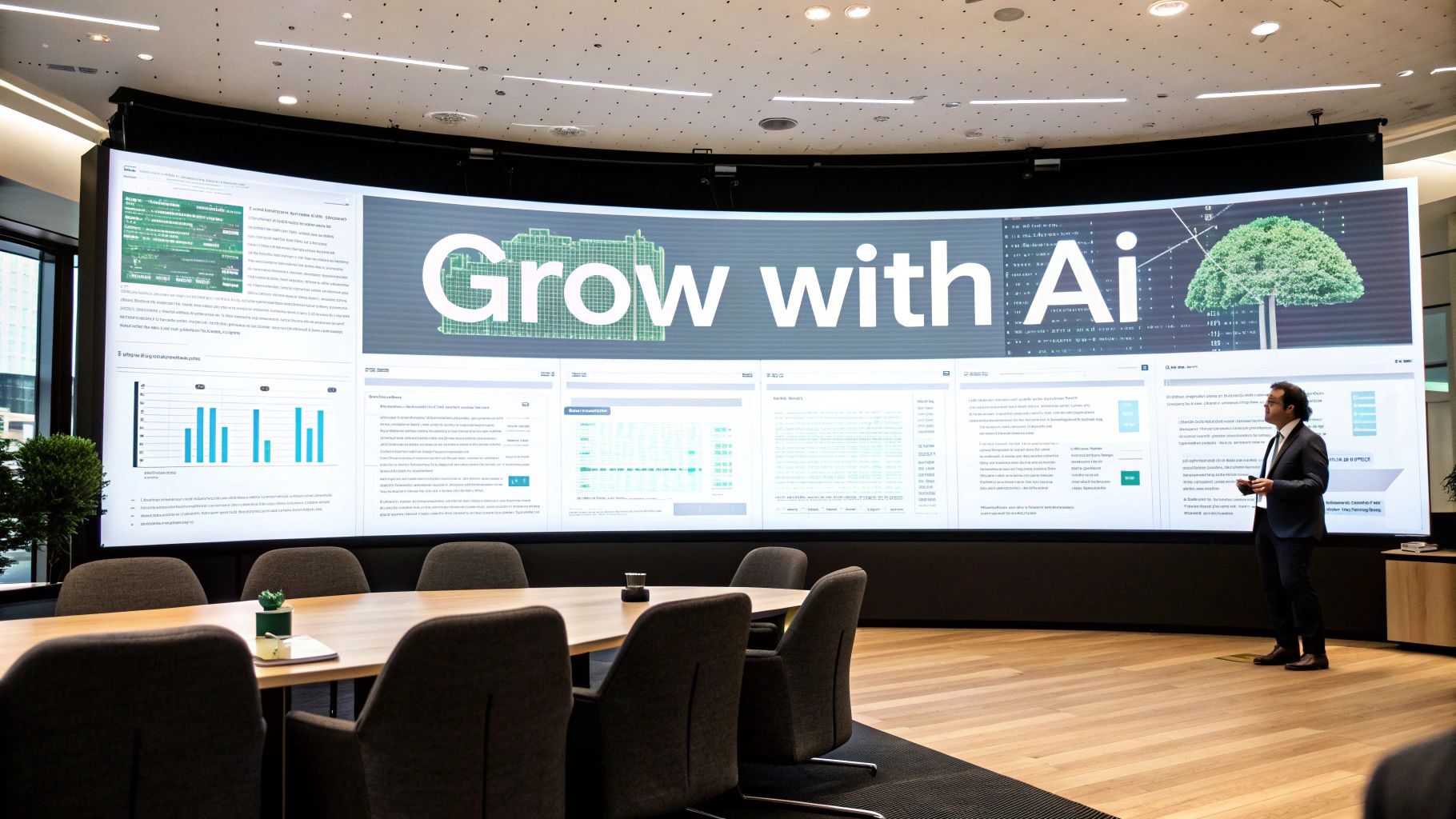Understanding the AI Revolution in Business Development

AI's role in business development has moved from theoretical discussions to practical applications that drive real results. Companies of all sizes are discovering how AI tools can help them work smarter and grow faster. But getting the most out of AI requires understanding both its capabilities and limitations. Let's explore how businesses are actually using AI to achieve measurable growth and what you need to know to implement it effectively.
The Current State of AI Adoption
The numbers tell a clear story about AI's growing importance in business. About 35% of companies are already using AI in their daily operations, while 42% are running pilot programs and 37% are developing formal AI strategies. These aren't just experiments – companies are seeing real results. Sales teams using AI-powered tools report significant increases in qualified leads and closed deals. However, many businesses find that implementing AI effectively takes more than just buying new software. Success requires careful planning, the right expertise, and realistic expectations about what AI can and cannot do.
Key Drivers of AI Adoption in Business Development
Several practical benefits are driving businesses to adopt AI solutions. The most immediate advantage is automation of routine tasks – when AI handles data entry and basic analysis, teams can focus on building relationships and closing deals. AI's ability to process massive amounts of customer data helps identify patterns that humans might miss, leading to better targeting and higher conversion rates. For example, when sales teams use AI to personalize their outreach based on customer behavior patterns, they often see response rates improve significantly. Companies are increasingly recognizing that AI isn't just a nice-to-have tool – it's becoming essential for staying competitive in sales and marketing.
Avoiding Common Pitfalls in AI Implementation
Success with AI requires avoiding some common mistakes that can derail implementation. Many companies jump into AI projects without a clear plan, leading to scattered efforts and disappointing results. Others forget that AI works best when it supports human teams rather than trying to replace them entirely. Data quality is another critical factor – AI systems need clean, accurate data to produce reliable insights. Finally, patience is essential. Companies often expect immediate results, but building effective AI systems takes time and continuous refinement. By understanding these challenges upfront and planning accordingly, businesses can create AI strategies that deliver real value over the long term.
Building Your AI Business Case

Adding AI to your company's growth strategy needs solid proof that it will pay off. This means going beyond surface-level hype and showing real business value through concrete numbers and results. Here's how to build a convincing case that will get key decision-makers on board by focusing on what matters most – measurable outcomes and practical ways to achieve them.
Calculating Potential Returns With AI for Business Development
The foundation of a strong business case starts with real numbers showing AI's impact on your bottom line. Look at specific metrics that AI can improve – for sales teams, this includes things like how many leads convert to customers, how long deals take to close, and the size of each sale. Marketing teams should focus on campaign performance, better customer targeting, and more engaging content. The numbers back this up – companies using AI to score leads have seen 50% more qualified prospects. These direct impacts on revenue make it much easier to justify investing in AI tools.
Identifying Quick Wins and Demonstrating Value
While long-term AI plans matter, showing early results builds crucial momentum. Start with "quick wins" – areas where AI can make an immediate difference that everyone can see. This often means automating routine work like entering data or screening leads, which frees up your team to focus on more valuable tasks like building relationships with customers. Companies typically cut operations costs by up to 40% through smart AI use. Being able to point to both improved efficiency and lower costs makes a compelling case for continued AI investment.
Building Stakeholder Buy-In for AI Initiatives
Getting key decision-makers on board requires clear communication about AI's benefits using real examples and data. Present a detailed plan that outlines costs, timelines, and expected returns. Address common worries upfront – especially around data security and changes to existing work processes. By showing you've thought through both opportunities and challenges, you'll build confidence in your AI proposals.
Frameworks for Measuring Success and Avoiding Pitfalls
Setting up clear ways to track progress is essential for proving AI's value. Choose metrics that directly connect to business goals and create regular reports to monitor performance. Key things to watch include how many leads become customers, the lifetime value of each customer, and how long sales take to close. Watch out for common problems like poor quality data, lack of AI expertise on your team, or unrealistic expectations. Deal with these issues early by planning ahead and bringing in outside help when needed. Consider working with specialized firms like Lean Sales Systems by Vytas Mikulenas that focus on B2B sales, marketing automation, and AI implementation. Their experience can help you avoid typical mistakes and ensure your AI projects deliver real business value.
Using AI to Build Better Customer Relationships

Smart companies are discovering that AI isn't just about making processes faster – it's about creating deeper, more meaningful connections with customers. While automation brings efficiency, the real value comes from using AI to understand and respond to customer needs in ways that build lasting loyalty and drive sustainable growth.
Creating Personal Experiences Through AI
AI makes it possible to treat each customer as an individual, even when serving thousands or millions. By analyzing customer data, AI helps businesses understand preferences and predict needs to deliver experiences that feel custom-made. For instance, when an online store uses AI to recommend products based on your past purchases, it creates a shopping experience uniquely suited to you. This personal touch helps customers feel valued and understood, which naturally strengthens their connection to the brand.
Using Data to Stay One Step Ahead
AI's ability to spot patterns in customer behavior allows businesses to address needs before they arise. By examining historical data, AI systems can identify signs that a customer might need help or be considering switching to a competitor. This allows companies to reach out proactively with relevant solutions. For example, if AI notices a customer's usage dropping off, it can trigger a personalized check-in from the support team. Taking action early shows customers you're paying attention and care about their success.
Keeping the Human Element While Using AI
The most effective approach combines AI's analytical power with genuine human interaction. Here's how successful companies strike this balance:
- Supporting Customer Service Teams: AI handles routine questions and data gathering, giving human agents more time to build relationships and tackle complex issues that need a personal touch.
- Smooth Handoffs Between AI and Humans: When a customer starts with an AI chatbot but needs more help, the conversation transitions naturally to a human agent who has the context to provide deeper support.
- Making Every Interaction Count: AI helps service teams understand each customer's history and preferences, enabling more meaningful conversations that strengthen relationships.
This balanced strategy lets businesses work more efficiently while building authentic connections with customers. Companies like Lean Sales Systems by Vytas Mikulenas help businesses integrate AI into their B2B sales and marketing in ways that enhance rather than replace human relationships. Their expertise in AI-powered outreach and engagement helps companies use technology thoughtfully to grow stronger customer bonds.
Creating an AI-Ready Workforce

Getting your business ready for AI goes beyond just picking software – it requires preparing your team to work in new ways. Your employees need to understand how AI can benefit their work, develop the right skills to use it effectively, and feel secure about their roles as these tools become part of daily operations.
Assessing Your Team's Current Skillset
Before diving into AI training, take stock of what skills your team already has. Think of it like doing a home inspection before renovating – you need to know what's working well and what needs improvement. Survey both technical abilities (like data analysis and software proficiency) and essential soft skills (such as adaptability and problem-solving). This gives you a clear picture of where to focus your AI training efforts.
Identifying Roles for AI Augmentation
AI will impact different roles in different ways. For some positions, AI tools will help employees work more efficiently and focus on higher-value tasks. Other roles may need significant retraining to stay relevant. For example, sales teams can use AI to analyze customer data and personalize outreach, giving them more time for building relationships. Leaders should carefully evaluate which roles will benefit most from AI support and prioritize training accordingly.
Developing Targeted Training Programs
With skill gaps identified, create focused training programs that match each team's needs. Just as different trades need different tools, various teams require different AI skills. Marketing teams might need training on AI analytics platforms, while sales teams could focus on AI-powered CRM systems. Consider partnering with specialized firms like Lean Sales Systems by Vytas Mikulenas to develop customized training that builds both basic AI knowledge and role-specific expertise.
Maintaining Morale During the Transition
Change can make people nervous, especially when it involves new technology. Address concerns head-on by clearly explaining how AI will support (not replace) your team's work. Show your commitment to employee growth by providing opportunities to learn new skills. Keep communication open and honest about AI's role in the company. When people understand how AI will make their jobs better rather than obsolete, they're more likely to embrace the changes with enthusiasm. Focus on specific examples of how AI helps each role and celebrate wins as teams start using AI tools successfully.
Implementing AI Across Different Business Functions
Companies across industries are actively using AI to power their growth and operations. From sales and marketing to finance and operations, AI tools and systems are making significant impacts in every department, each with their own specific benefits and use cases.
AI-Powered Sales: Personalization and Prediction
Modern sales teams rely heavily on AI to better understand and serve their customers. AI systems analyze customer behavior and purchasing patterns, giving sales reps the insights they need to have more meaningful conversations. A sales rep can now see exactly what products might interest a specific customer and when they're most likely to buy. AI tools also help predict future sales trends and identify the most promising leads, so teams can focus their energy where it matters most. This data-backed approach helps close more deals while building stronger customer relationships.
AI-Driven Marketing: Enhanced Targeting and Engagement
Marketing teams are seeing major gains through AI adoption. Instead of broad, generalized campaigns, AI helps create highly targeted messages that speak directly to specific customer groups. This precise targeting means better results and less wasted ad spend. AI also handles many routine marketing tasks automatically – from scheduling social posts to optimizing email send times – freeing up marketers to focus on strategy and creativity. The result is more effective campaigns that build real connections with customers.
Streamlining Operations With AI
AI is making operations more efficient across every part of the business. Manufacturing plants use AI-powered robots to speed up production while improving quality. Distribution centers rely on AI to predict inventory needs and optimize delivery routes. One of the biggest benefits is in maintenance – AI can spot potential equipment problems before they cause costly breakdowns. These improvements add up to smoother operations and better service for customers.
AI in Finance: Data-Driven Insights and Risk Management
Finance teams are using AI to make smarter decisions and reduce risks. AI systems quickly spot trends and unusual patterns in financial data that humans might miss. This helps with everything from detecting fraud to making investment choices. AI also speeds up routine financial tasks like creating reports and checking compliance requirements. For lending decisions, AI models can assess credit risk more accurately than traditional methods, leading to better loan decisions with less risk.
Cross-Functional Implementation and Consistent Results
Getting the full value from AI requires careful planning across departments. Companies need to first identify their biggest challenges, then choose AI tools that specifically address those needs. Just as important is making sure employees understand how to use these new tools effectively through proper training and support. Many companies work with specialized firms like Lean Sales Systems to guide their AI implementation. These experts help companies avoid common mistakes and get better results from their AI investments.
Building Long-Term AI Success
Creating real value with AI in business development requires more than just implementing a few tools – it needs a thoughtful, structured approach that becomes part of your company's DNA. Just like adopting any major business innovation, success with AI comes from building the right foundations, nurturing a supportive environment, and having clear plans for growth. Let's explore how to create lasting success with AI in your business development efforts.
Cultivating an AI-First Culture
The key to long-term AI success starts with your people and culture. Rather than viewing AI as a replacement for human talent, focus on showing your team how AI can make their work more impactful and interesting. Start by opening up conversations about AI's potential benefits, provide hands-on training opportunities, and celebrate early wins to build momentum. Just as businesses had to adapt to the internet age, embracing AI requires shifting mindsets and working methods. When teams feel empowered rather than threatened, they're more likely to experiment with AI and find innovative ways to use it.
Maintaining a Competitive Edge Through Continuous Innovation
The field of AI moves quickly, with new capabilities emerging all the time. Staying competitive means keeping up with these changes while finding practical ways to apply them to your business. The most successful companies take time to understand industry trends, test new approaches, and refine their AI strategies based on real results. For example, you might explore using AI to create personalized outreach content – but always with clear business goals in mind. The key is balancing innovation with pragmatism to find AI applications that truly drive value.
Scaling Successful AI Initiatives Across Your Organization
Once you've proven AI's value in small projects, the next challenge is expanding those successes throughout your company. Think of it like opening new store locations – you need to maintain what works while adapting to each area's specific needs. For instance, an AI solution that works well in sales might need adjustments before it can benefit marketing or customer service teams. Success at scale requires careful planning, clear communication about changes, and metrics to track progress. Take time to customize tools, train teams properly, and align AI initiatives with each department's objectives.
Frameworks for Long-Term Planning, Risk Management, and Measuring Ongoing Success
Creating lasting value with AI requires solid foundations in planning, risk management, and performance measurement. Start by developing a clear roadmap that outlines both immediate priorities and future goals. Address potential challenges upfront, especially around data security and ethical AI use. Set specific metrics to track progress – like changes in conversion rates, customer lifetime value, or operational efficiency. Regular monitoring helps you spot what's working and where adjustments are needed. This structured approach helps ensure your AI investments deliver consistent value over time.
To make sure your AI journey starts strong and stays on track, consider working with specialists like Lean Sales Systems by Vytas Mikulenas. Their focus on B2B sales, marketing automation, and practical AI implementation can help you develop and execute an effective long-term AI strategy that drives real business growth.




